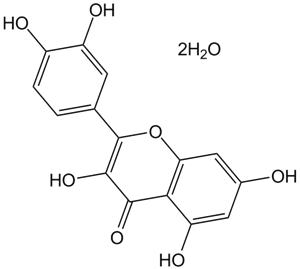Quercetin dihydrate |
| Catalog No.GC15665 |
PLA2 and PI 3-kinase inhibitor
Products are for research use only. Not for human use. We do not sell to patients.

Cas No.: 6151-25-3
Sample solution is provided at 25 µL, 10mM.
Quercetin (dihydrate), a natural flavonoid, is a stimulator of recombinant SIRT1 and a PI3K inhibitor with IC50s of 2.4 μM, 3.0 μM and 5.4 μM for PI3K γ, PI3K δ and PI3K β, respectively[1].
Quercetin (dihydrate) is a type of plant-based chemical, or phytochemical, used as an ingredient in supplements, beverages or foods. In several studies, it may have anti-inflammatory and antioxidant properties, and it is being investigated for a wide range of potential health benefits[1].Quercetin (dihydrate) is a PI3K inhibitor with IC50s of 2.4-5.4 μM. Quercetin dihydrate (Sophoretin dihydrate) strongly abrogates PI3K and Src kinases, mildly inhibits Akt1/2, and slightly affected PKC, p38 and ERK1/2[1].Quercetin (dihydrate) inhibits TNF-induced LDH% release, EC-dependent neutrophils adhesion to bovine pulmonary artery endothelial cells (BPAEC), and BPAEC DNA synthesis and proliferation[2].
References:
[1]. Navarro-Núñez L, et al. Effect of quercetin on platelet spreading on collagen and fibrinogen and on multiple platelet kinases. Fitoterapia. 2010 Mar;81(2):75-80.
[2]. Yu XB, et al. Inhibitory effects of protein kinase C inhibitors on tumor necrosis factor induced bovine pulmonary artery endothelial cell injuries. Yao Xue Xue Bao. 1996;31(3):176-81.
[3]. Yang F, et al. Combination of Quercetin and 2-Methoxyestradiol Enhances Inhibition of Human Prostate Cancer LNCaP and PC-3 Cells Xenograft Tumor Growth. PLoS One. 2015 May 26;10(5):e0128277.
Average Rating: 5 (Based on Reviews and 26 reference(s) in Google Scholar.)
GLPBIO products are for RESEARCH USE ONLY. Please make sure your review or question is research based.
Required fields are marked with *




